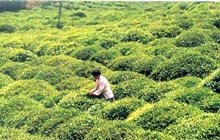
 Tea is one of ancient China's many inventions. The English word "tea" is derived from the word te, which hails from the southern port town of Xiamen (Amoy). Although it was only introduced to Europe and America in the seventeenth century, human cultivation of tea plants dates back two thousand years in China. In fact, during the Neo-Daoist revival of the ninth and tenth centuries, tea became an integral part of scholastic life. The preparation and drinking of tea symbolized man's potential for harmony with nature. The tea ceremony came to be a theater for spiritual enlightenment through the contemplation of the universe.
Tea is one of ancient China's many inventions. The English word "tea" is derived from the word te, which hails from the southern port town of Xiamen (Amoy). Although it was only introduced to Europe and America in the seventeenth century, human cultivation of tea plants dates back two thousand years in China. In fact, during the Neo-Daoist revival of the ninth and tenth centuries, tea became an integral part of scholastic life. The preparation and drinking of tea symbolized man's potential for harmony with nature. The tea ceremony came to be a theater for spiritual enlightenment through the contemplation of the universe.
This article lists the various categories of tea available in China and describes the process for making Hangzhou's famous Longjing tea. For more information, join us on a tour of Hangzhou's tea museum.
The Various Categories of Tea
1) Green tea . So called, since the green tea leaves are not fermented during processing, thereby maintaining the original colour. Famous examples are Longjing tea of Zhejiang province, Maofeng of Huangshan Mountain in Anhui province and Biluochun produced in Jiangsu province.
2) Black tea . Developed after green tea, it incorporates fermentation within the baking process. The best brands are Qihong of Anhui province, Dianhong of Yunnan, Suhong of Jiangsu, Chuanghong of Sichuan and Huhong of Hunan.
3) Wulong tea . This represents a variety half way between green and black teas. It is a special tea made and enjoyed in Fujian, Guangdong and Taiwan – all located on China's south-east coast.
4) Compressed tea . Also known as "brick tea" because it is compressed and hardened into a brick-like shape, this tea is convenient for transportation and storage. It is often supplied to nomadic peoples on China's borders, e.g. to clans in Mongolia.
5) Scented tea . This is made by mixing fragrant flowers with the tea leaves during processing. The flowers most commonly used for this are jasmine and chrysanthemum.
To Make Green Tea
To make Longjing (Dragon Well) Tea, bushes must be picked between twenty to thirty times between March and October. This is not done by machine but by hand, with an experienced leaf-picker able to collect six hundred grams or nine thousand green tea leaves per day. For all but the very finest tea, these fresh leaves are immediately parched by machine in electrically heated cauldrons.
Six hundred grams of fresh green leaves (or one day's worth of picking), after baking, will leave you with one hundred fifty grams of parched tea.